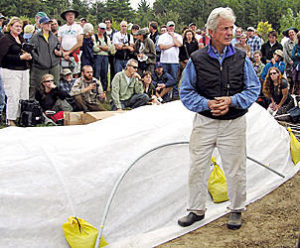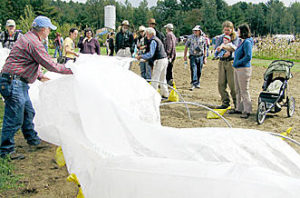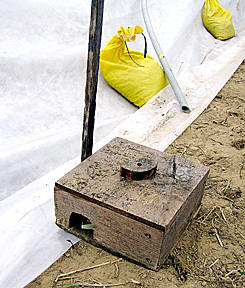 |
| Eliot Coleman, at the 2007 Common Ground Country Fair, demonstrated a new way to extend the growing season: Sow double beds with lettuce, spinach and other cold-tolerant crops in early October; cover the beds with hoops and row covers; and around Thanksgiving, add a second cover of greenhouse plastic. The crops should be protected over winter and ready to eat in early spring – at a cost far less than covering an equal area with a greenhouse. English photo. |
by Jean English
Eliot Coleman has another great idea – one that will extend the growing season at far lower cost than the $1500 or so required for a hoop house. His plan, which he started experimenting with last year, involves planting pairs of 30-inch-wide beds of hardy crops on the first of October, covering them immediately with polyester row covers such as Reemay or Agribon (Coleman uses the 15-weight cover) supported by half-inch metal or PVC hoops; and then, in mid-November, setting greenhouse plastic over the row cover for added insulation. The double covering will take hardy, young crops through winter and provide fresh produce in early spring.
Coleman quickly set up one of these very low tunnels at MOFGA’s 2007 Common Ground Country Fair. First, using a spud bar, he made 12-inch-deep holes in the sandy soil. Then he set bent, half-inch-diameter, 10-foot-long PVC electrical conduit, from which he’d cut off the flanged end, into the holes along each edge of the side-by-side, 30-inch-wide beds. One foot of conduit was stuck into the ground on each side, leaving an 8-foot length curving over the beds. The hoops were spaced 5 feet apart along the length of the two 50-foot-long beds, requiring 11 hoops, costing about $22. (Ten-foot lengths of half-inch conduit cost under $2 each.) Coleman said he preferred to avoid PVC and use half-inch metal conduit, which costs about the same, but that he had not yet completed the simple pipe bender to give each metal hoop the desired curved shape. He added that Johnny’s Selected Seeds should have “a nice little pipe bender/former/bower by next fall at the latest.”
 |
| Ten-foot-long pieces of metal or PVC conduit are stuck in the ground, a foot deep on each side. |
 |
 |
| Coleman and fairgoers spread row cover over the hoops. English photos. |
Next, Coleman draped 10-foot-wide row cover over the hoops and placed small grain bags filled with gravel on the edges of the row cover at each hoop, to hold the cover in place. Fabric extending at the ends of the row was bunched and pulled snug, tied securely with a cord, and the cord was tied to a wooden stake in the ground. The tension of the fabric created by pulling each end taut to the stake strengthens the structure.
Coleman and his wife, Barbara Damrosh, then showed how plastic would be draped over the row cover in mid-November, simply setting it atop the low structures, resetting the gravel-filled bags on the edges, and tying off the ends to hold it down. He noted a friend’s suggestion that the bags could be filled with sand or soil instead of gravel; soil could simply be poured onto the garden when the structure was removed for the summer.
The mid-November covering date helps prevent the air and soil under the structure from getting too hot. If a warm spell does occur after that date, the sides of the structure can be propped up for ventilation. “Try not to let the temperature go over 80,” said Coleman. If snow seems imminent before that date, put the plastic on early, since the fabric row cover isn’t strong enough to hold snow.
At a cost of $22 for the pipes to cover two 50-foot beds, you could cover six of them for $66. Six 30-inch-wide beds is the area covered by a 21- x 50-foot greenhouse. Using these quick hoops, the cost would be 95% less and the protection would be much easier to construct.
For vole control, Coleman builds small wooden boxes with a removable cover and with a mouse-sized hole on each of two sides. He places a set trap inside each hole (The Better Mousetrap, from Intruder, Inc., www.intruderinc.com) and adds a long handle for carrying the box. “Don’t use bait,” he advised. “Just spring the traps.” Voles eventually associate the smell of baits with the death of fellow voles; without bait, they encounter a “small dark hole that smells like vole” after the first vole has entered, and they enter the box and run into the trap. Empty the traps daily.
Sowing and covering dates and construction details will vary with locations, crops and weather. For example, Coleman suggested that on the day after Thanksgiving, when you need exercise, you might sow peas and carrots, and then add the plastic. The seeds will then sit in the soil over winter and should germinate in March. In early October, you might sow lettuce and spinach, which are very hardy as young plants, for March or April harvests. “You’re not gardening in winter,” he said, noting that many people say they don’t want to garden year-round; “you’re just planting in November, and [the crop] sits” – although you probably could sow spinach and lettuce under one of these structures a few weeks earlier and eat baby greens from the bed through winter, he added.
Crops likely won’t need to be watered, due to the lack of evaporation and to the high water table in winter.
 |
| A vole trap entices the animals. English photo. |
 |
| Inside, the box holds two unbaited traps (The Better Mousetrap, by Intruder, Inc.). English photo. |
Experiment, said Coleman. Gardeners in areas expecting a heavy snow load might want to use twice as many hoops. Try producing a lucrative, early crop of blanched asparagus by covering hoops over an asparagus bed with black plastic instead of clear. Make a taller tunnel by putting 2-foot-long pieces of rebar in the ground, burying 1 foot and leaving the other foot above ground. Slide the hoops over the top of the rebar, and drape wider row covers and plastic over these slightly taller structures. “Don’t go much higher, though,” he warned: “Wind could be a problem.”
Coleman and Damrosh often sow experimental plantings thicker than recommended, since they don’t know how crops will germinate under cooler conditions. If germination is good, they simply end up with extra baby greens.
He urged fairgoers to report results to The Maine Organic Farmer & Gardener (c/o [email protected]) for compilation and publication in a coming issue. One fairgoer said to run a rope across the tops of the hoops, securing it to each hoop with a clove hitch; after a snow, simply pull the rope at one end to shake off the snow.
